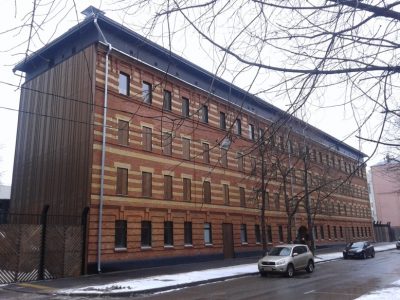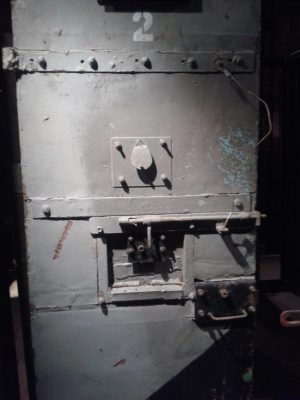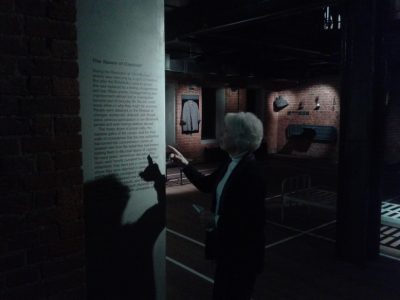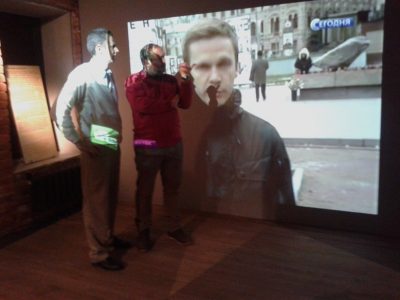Sharon Tennison

…. A drizzly gray day in Moscow …. patches of brownish snow and ice still on sidewalks ….
We arrived at the new “Gulag Museum,” a grim building which had been denuded of traditional Russian plaster, paint or any effort to make it look hospitable. External bare bricks left to the elements––rain, snow, ice, freezing winds––not unlike millions of inhabitants of the former gulags. The harsh exterior had apparently been deemed appropriate for this national museum which presents in detail the grim facts behind the Soviet Union’s infamous and heretofore little acknowledged years. The earliest gulags opened in 1918, and the last closed in 1953.
Waiting for us at the gray entrance was Alexei Pankin, a Moscow friend from the 1990s who has had experience in every form of Soviet and Russian journalism from the late 80s forward.
Since 1983 I had wondered if it would ever happen that Russians would be far enough removed from this nationwide horror to open up the wounds of their tragic Soviet past.
During the 1980s many diverging points of view existed regarding this history. Numerous Soviets we met knew of these events since close family members had perished in these God-forsaken outposts; others were disbelieving thinking that rumors were created by suspicious and disreputable Russians; yet others acknowledged the pain and suffering of the period …. but pointed out that if Stalin had not built the USSR with the labor of these camps, Hitler’s millions in uniforms would have wiped Russia off of the face of the earth––concluding that today’s Russians would be speaking German instead of their own native tongue. On the whole most Soviet people kept quiet about what they knew or didn’t know, since the USSR was a society where one didn’t share information due to fear of consequences to oneself or others. I listened intently over the years still wondering if there would ever be a time when Russians would fully understand and deal with these decades.
That day has finally come.
The Russian Federation, and no doubt Putin himself, has put painful self-examination and a great deal of money into opening the pages of this unbelievably horrendous period. Russian designers must have worked assiduously to bring alive the happenings of those years particularly from the 30s, 40s and up to 1953––the year Stalin died.

Walking through the dull pewter museum doors we found ourselves in a stark open chamber displaying numerous thick, heavy metal doors brought to this site from the actual gulags. Oversized locks were clasped on their hinges. The doors look impenetrable …. once behind them one could never hope to get out. The next display showed heavily patched, worn-out prison garments that inmates had mended and re-mended––documenting the evidences of how human beings had survived, tried to keep warm, thus making life bearable for themselves and others coming along behind them….who would also perish in these make-shift concentration camps.
The camps served two purposes: 1) to incarcerate any and all who were suspected of lacking loyalty to Stalin and the new communist future, and 2) to house the “human fodder” that would be consumed to build the new Soviet society from the ground up. The USSR, the largest nation in the world, was undeveloped compared to Europe, America and Great Britain. Massive projects were drawn up which were just dreams at that time: bridges that spanned wide gorges and large rivers, huge dams to create power, massive power plants to assist the “electrification” of the countryside where people were still using candles and firelight after sundown, many minerals in far away places to be mined, and endless other undertakings that would be essential to support the new communist dream in Stalin’s warped mind. Stalin was determined that the USSR would survive both its internal and external enemies and build a new social experiment in the world. He apparently considered any suffering or loss of life a justifiable sacrifice.
By March 1940, 53 Gulag camps and 423 labor colonies existed across the USSR. Today’s major industrial cities of the Russian Arctic such as Norilsk, Vorkuta and Magadan were originally labor camps built by prisoners.

As for the museum, its inner walls are painted shades of gray-to-black with exposed brick scattered throughout the floors. Small recessed ceiling lights pierce the darkness. Daily survival and labor implements have been brought to this building to demonstrate the harshness and hopelessness of life in these camps as inmates labored with insufficient clothing, scant food and endless work until they dropped.
Huge wall-size videos, again in shades of gray, depict camp life with stark realism. Some walls were covered with bleak descriptions and quotes from those who had passed through, or with stories told by those eventually released after Stalin’s demise.
To understand this deeply complex reality, be sure to visit the Gulag Museum if you travel to Moscow.
The history of the gulags was finally opened up under Gorbachev in the late 1980s. He initiated glasnost and perestroika, saying “We must fill in the ‘white pages’ of our history.” I remember when Moscow newspapers gave Soviet peoples the right to write in what they remembered during those years to national daily papers (in both Russian and English versions). Their messages were heart-rending. While a catharsis for many, they were a horror-come-true for those who had earlier chosen to believe it was all “rumors.”

During the decade of the 1990s, Russians lost the last vestiges of hope that theirs was a decent culture. It was a gut-wrenching era as the largest nation in the world fell apart and no one knew how to bring it back together again.
Another ten years would pass during which Russians would be forced to find various ways to survive. Wild West capitalism and oligarch capture of major Soviet industries robbed the new country of its financial underpinnings. Scarcity of basic foods, medicines, clothing, and everything else needed to survive, appeared. Deprivations of all sorts existed. Barter became the currency of the decade; bartering loops as diverse as trading truck loads of sugar, for truck tires, workers’ uniforms, and services at a local hospital, became normal fare. At the end of the 90’s, the ruble crashed for its second time within the decade, wiping out much of the nascent small business sector that had just begun developing. I watched with horror as young Russian alumni of CCI’s business training programs in America lost their small companies.
This was the Russia that a quiet and unknown VV Putin came into after being elected president in year 2000. He slowly began his first months as Russia’s new president amid much skepticism. I was sure he would fail. I had hoped a strong man would come in and clean out the oligarchs, in addition to the petty thugs (roofs they were called) who were living off of small business extortions. I wanted someone who was strong, who would halt the off-shore, tax-free islands where the oligarch’s profits were immediately sent.
The Kremlin itself was run by the powerful oligarchs. However, within a couple of years of Putin’s coming to power, they began to be reigned in. Slowly new laws were experimented with to aid young businessmen and women. The struggle to create a different society out of absolute chaos and lawlessness was beginning to take hold––but it would take decades to convert the mindset of a whole nation of people and most of their leaders away from the ingrained cultural habits of past centuries.
Overall, the last 16 years across Russia have seen a remarkable rise in business development. They have seen new laws across the spectrum and the rebuilding of Moscow and Russian cities to the south and out across the Ural mountains, Siberia and the Far East. And they have seen a restoration of classical arts across 11 time zones, from Kaliningrad to Kamchatka. One could have never imagined this in the year 1999! Only those who have lived through this period in Russia can fully appreciate the dramatic changes in the life of this nation.
After leaving the museum, we walked with Alexei a few blocks through a residential neighborhood to a wildly colorful Ukrainian restaurant where the finest of the new Russia’s Ukrainian cuisine was served by welcoming talkative waitresses and waiters in native costumes and elaborate headdresses. The pride and hope on display at the restaurant was in dramatic contrast to the abject hopelessness we had just experienced in the museum.
